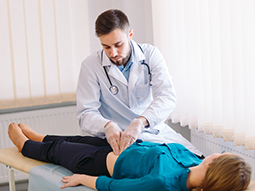A hernia is a bulge that develops as a result of weakened muscles in the abdomen. When the abdominal muscles are compromised, abdominal tissues and/or organs such as the intestines can protrude into this weakened area. When this occurs in the lower abdominal wall in the area of the groin, this is referred to as a groin hernia or an inguinal hernia. A groin hernia can develop in both females and males, but it is more common in males.
Groin (Inguinal) Hernia
An inguinal hernia occurs in the groin area, where part of the intestine slips through a tear in the abdominal muscle and protrudes through a weakened spot in the inguinal canal - an opening in the lower abdomen.
Symptoms
If you experience any of the following symptoms, contact a doctor:
- A bulge in the lower abdomen in the groin area
- Increased pain in the groin when straining, such as coughing and lifting heavy objects
- In men, swelling and/or pain around the testicles
Causes
In males, a groin hernia, also known as an inguinal hernia, can develop very early in life. As male fetuses develop, the testicles drop into the scrotum through a pathway called the inguinal canal. After birth, the inguinal canal closes in order to prevent the testicles from moving back up through this channel. If the canal does not close completely or properly, it leaves a weakness in the abdominal muscles and can lead to a hernia.
Factors that place individuals at risk of developing a groin hernia include:
- Pregnancy
- Fluid in the abdomen
- Obesity
- Frequent straining during bowel movements
- Chronic acute cough
Patients who suspect groin hernia should call a doctor. If it begins to grow, or if experiencing nausea and/or vomiting, this may require immediate attention.
What to expect at your appointment
During your appointment, your doctor will ask you questions about your symptoms and will perform a physical examination. In order to make a definitive diagnosis and assess the severity of the hernia, your doctor may prescribe one of the following diagnostic techniques:
- MRI scan
- CT scan
- Ultrasound imaging
Additionally, your doctor may want to check for any signs of infection by prescribing a blood test or a urine test.
Treatment
Non-surgical Treatments
Groin hernias do not heal on their own and can cause serious health complications if left untreated. Patients may not need surgery to repair it right away. However, once the hernia begins to grow and cause more pain, this may indicate the need for surgical intervention.
Surgical Treatment and Post-Treatment
The goal of groin hernia surgery is to repair the gap in the abdominal wall and return the protruding tissues and organs to their natural position. This can be repaired using a variety of surgical techniques. The surgeon will determine which procedure is likely to be most successful by considering the size and complexity of the hernia in addition to the patient’s symptoms.
Laparoscopic repair
If it is smaller in size, laparoscopic groin hernia repair may be an option. Laparoscopic repair uses three to four smaller incisions and an instrument called a laparoscope, a small tube with a camera on the tip, to guide surgeons. The nature of laparoscopic repair as a minimally invasive procedure generally allows patients to go home the same day of the procedure and return to daily activities within one to two weeks.
Open groin hernia repair
If the hernia is larger in size and more complex, this type of repair may be necessary. Open repair requires one long incision which allows for greater visibility and dexterity for the surgeon. Some patients may need to stay in the hospital for a few days after an open repair, depending on the complexity of the surgery, and can return to daily activities one to three weeks after the procedure.
Our providers

Expert hernia care
Getting the care you need starts with seeing one of our hernia specialists.









